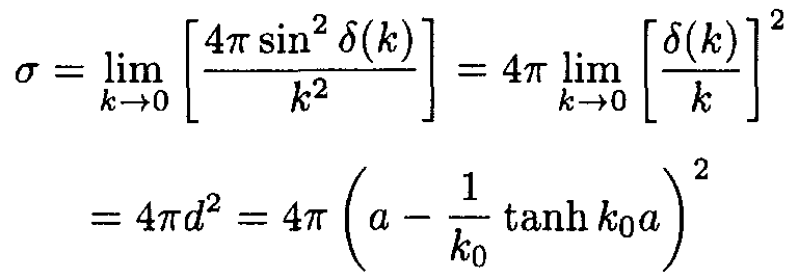
Repulsive Square Well
 المؤلف:
Sidney B. Cahn, Gerald D. Mahan And Boris E. Nadgorny
المؤلف:
Sidney B. Cahn, Gerald D. Mahan And Boris E. Nadgorny
 المصدر:
A GUIDE TO PHYSICS PROBLEMS
المصدر:
A GUIDE TO PHYSICS PROBLEMS
 الجزء والصفحة:
part 2 , p 75
الجزء والصفحة:
part 2 , p 75
 21-8-2016
21-8-2016
 1544
1544
Repulsive Square Well
Consider in three dimensions a repulsive (V0 > 0) square well at the origin of width a. The potential is
 (1)
(1)

Figure 1.1
A particle of energy E = h2k2/2m < V0 is incident upon the square well (see Figure 1.1).
a) Derive the phase shift for s-waves.
b) How does the phase shift behave as V0 → ∞?
c) Derive the total cross section in the limit of zero energy.
SOLUTION
a) If the radial part of the wave function is R(r) then define χ(r) = rR(r). Since R is well behaved at r → 0, χ = 0 in this limit. The function χ(r) obeys the following equation for s-waves:
 (1)
(1)
where
 (2)
(2)
and the theta function Θ(a – r) is 1 if a > r and 0 if a < r. For r > a the solutions are in the form of sin kr or cos kr. Instead, write it as sin(kr + δ) where the phase shift is δ(k). For r < a define a constant α according to α2 = k20 – k2 > 0. Then the eigenfunction is
 (3)
(3)
For r < a the constraint that χ(0) = 0 forces the choice of the hyberbolic sine function. Matching the eigenfunction and slope at r = a gives
 (4)
(4)
 (5)
(5)
Dividing these equations eliminates the constants A and B. The remaining equation defines the phase shift.
 (6)
(6)
 (7)
(7)
b) In the limit that V0 → ∞, the argument of the arctangent vanishes, since the hyperbolic tangent goes to unity, and δ = -ka.
c) In the limit of zero energy, we can define
 (8)
(8)
 (9)
(9)
To find the s-wave part of the cross section at low energy, we start with
 (10)
(10)
where the total cross section is σ.
 الاكثر قراءة في مواضيع اخرى
الاكثر قراءة في مواضيع اخرى
 اخر الاخبار
اخر الاخبار
اخبار العتبة العباسية المقدسة


